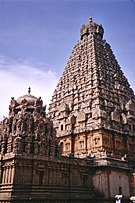| Part of a series on |
| History of Tamil Nadu |
|---|
 |
| Part of a series on |
| Andhra Pradesh and Telangana |
|---|
 |
| History and Kingdoms |
The Nayakas of Kalahasti were a line of rulers of Kalahasti and Vandavasi principalities.[1][a] Members of the group include Damarla Chennapa Nayaka, after whom the city of Chennai is named.[2][3] The Kalahasti Nayaks had their origins in the Velama warrior clans of present-day Andhra Pradesh.[4] These Nayakas served as vassals of the late Vijayanagara Empire, then held by the Aravidu Dynasty and headquartered at Chandragiri and Vellore.
- ^ Srinivasachari 1943, p. 94
- ^ "District Profile - CHENNAI". Chennai.tn.nic.in. Archived from the original on 14 January 2016. Retrieved 7 September 2009.
- ^ Srinivasachari 1939, pp. 63–69.
- ^
- Alpana Pandey, ed. (2015). Medieval Andhra: A Socio-Historical Perspective. Partridge Publishing. ISBN 9781482850178.
By this time there were many Velama principalities whose were called the Nayakas. Some of the famous Velama Nayakas of the time were those of the Kalahasti, Bellamakonda, jataprolu, bobbili, Velugodu Principalities.
- Ravula Soma Reddy, ed. (2007). Studies in the Socio-economic History of Medieval: Andhra Desa. Research India Press. p. 150. ISBN 9788189131142.
Another interesting thing to be noted in this connection is that several Velama Chiefs , after the conquest of the Rachakonda and Devarakonda Kingdoms carved out small principalities small principalities like those of Velugodu ( Kurnool district ) , Venkatagiri , Kalahasti , Bellamkonda and Nuzividu ( coastal Andhra ) in the Vijayanagara Empire , during the period of the last Sangama rulers.
- Alladi Jagannatha Sastri, ed. (1922). A Family History of Venkatagiri Rajas. Addison Press. p. 78.
According to the social right established so early as during the days of the second descendant Prasaditya Naidu , under orders of the Emperor Ganapathi Rai , making the Padmanayaka Velamas the first and foremost in rank , the chiefs belonging to the other seventy - six Velama sects , Damara Venkatapathi Naidu of Kalahasti included , paid the customary respects to the Rajah on this occasion by keeping themselves standing . Damara Venkatapathi Naidu himself being the brother - in - law of the Rajah was allowed a seat in the south - east of the hall
- W. Francis, ed. (1989). Gazetteer of South India. Mittal Publications. p. 20.
Kalahasti Zamindari - One of the largest zamindari estates in Madras, situated partly in North Arcot District, partly in Nellore, and partly in Chingleput. Number of villages, 406 in North Arcot, 201 in Nellore, and 206 in Chingleput; area, 638 square miles in North Arcot, 576 in Nellore, and 250 in Chingleput; total population (1901), 223,327. The capital is the town of Kalahasti, where the zamindar resides. The history of the family, which belongs to the Velama caste, is obscure. The original owner of the estate probably received it from a king of the Vijayanagar dynasty in the fifteenth century, on condition of maintaining order. The estate at one time spread as far as the site of Fort St.George, and the Company obtained the land on which Madras now stands from the proprietor in 1639. The settlement is traditionally said to have been named Chennappapatnam in honour of the zamindar's father. The estate came under British control in 1792, and a formal grant to the family was made in 1801. The zamundar afterwards received the hereditary title of Raja. The gross income amounts to over 5 lakhs.
- Illustrated Guide to the South Indian Railway. Higginbotham Publishing. 1900. p. 336.
The Rajahs of Kalahasti appear to have always belonged to the Velama caste and to have come south with the Vijayanagar kings who made them menkavalgars or minor custodians , from which position they rose to be Poligars.
- R. Parthasarathy, ed. (1984). Andhra Culture: A Petal in Indian Lotus. Government of Andhra Pradesh. p. 120.
- C. D. Maclean, ed. (1982). Maclean's Manual of the Administration of the Madras Presidency. Asian Educational Service. p. 58.
- Alpana Pandey, ed. (2015). Medieval Andhra: A Socio-Historical Perspective. Partridge Publishing. ISBN 9781482850178.
Cite error: There are <ref group=lower-alpha> tags or {{efn}} templates on this page, but the references will not show without a {{reflist|group=lower-alpha}} template or {{notelist}} template (see the help page).
